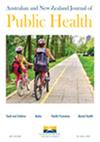“基本上,我的答案是,需要有选择!”向公众提供免费月经产品的建议:对澳大利亚维多利亚州边缘群体的定性探索。
IF 2.4
3区 医学
Q2 PUBLIC, ENVIRONMENTAL & OCCUPATIONAL HEALTH
Australian and New Zealand Journal of Public Health
Pub Date : 2025-02-01
DOI:10.1016/j.anzjph.2024.100219
引用次数: 0
摘要
目的:各国政府宣布了免费提供月经用品的政策。我们的研究旨在通过了解边缘化群体的月经产品不安全性及其对产品提供的建议来告知这些举措。方法:我们对月经产品不安全的参与者进行了深入访谈,他们被确定属于一个或多个边缘化群体,以及为这些人群服务的组织工作的关键线人。这些群体包括低收入人群、住房不安全人群、残疾人、多元文化群体、性别多元化人群和年轻人。采用框架方法进行定性内容分析。结果:参与者30人,关键举报人5人。与会者对提供服务的建议强调便利性、产品选择和优先考虑最需要的人,同时防止滥用。与会者还考虑了交付机制的隐私性和可见性与通过产品提供政策解决其他月经需求(包括教育和污名化)之间的平衡。结论:没有单一的交付方式最适合所有人的需求。交付机制必须考虑如何提供参与者推荐的功能。对公共卫生的影响:为了最好地减少月经产品的不安全性,各国政府应考虑通过多种机制提供产品。与预期受益者共同制定政策实施方法,并进行彻底的评估,将有助于吸收。本文章由计算机程序翻译,如有差异,请以英文原文为准。
“Basically, my answer is, there needs to be options!” Recommendations for the delivery of free menstrual products to the public: A qualitative exploration among marginalised groups in Victoria, Australia
Objective
Governments have announced free menstrual product provision policies. Our research aimed to inform these initiatives by understanding menstrual product insecurity amongst marginalised groups and their recommendations for product provision.
Methods
We undertook in-depth interviews with participants experiencing menstrual product insecurity, who identified as belonging to one or more marginalised groups, alongside key informants working for organisations serving these populations. Groups included those on low income, people experiencing housing insecurity, people living with disabilities, multicultural groups, gender-diverse people, and young people. Qualitative content analysis was undertaken using a framework approach.
Results
Thirty participants and five key informants participated. Participant recommendations for service delivery emphasised convenience, product choice and prioritisation of those with the greatest need whilst preventing misuse. Participants also considered the balance between the privacy and visibility of delivery mechanisms and the opportunity to address other menstrual needs including education and stigma through product provision policies.
Conclusions
No single delivery approach best suits the needs of all people. Delivery mechanisms must consider how to provide participants’ recommended features.
Implications for Public Health
To best reduce menstrual product insecurity, governments should consider delivering products through multiple mechanisms. Co-development of policy implementation methods with intended beneficiaries, and thorough evaluation, will support uptake.
求助全文
通过发布文献求助,成功后即可免费获取论文全文。
去求助
来源期刊

Australian and New Zealand Journal of Public Health
医学-公共卫生、环境卫生与职业卫生
CiteScore
4.20
自引率
5.70%
发文量
121
审稿时长
6-12 weeks
期刊介绍:
The Australian and New Zealand Journal of Public Health (ANZJPH) is concerned with public health issues. The research reported includes formal epidemiological inquiries into the correlates and causes of diseases and health-related behaviour, analyses of public policy affecting health and disease, and detailed studies of the cultures and social structures within which health and illness exist. The Journal is multidisciplinary and aims to publish methodologically sound research from any of the academic disciplines that constitute public health.
 求助内容:
求助内容: 应助结果提醒方式:
应助结果提醒方式:


